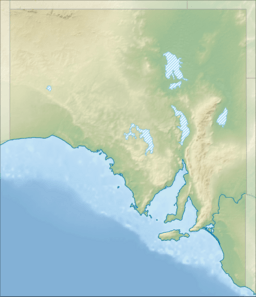Lake Hope (South Australia) facts for kids
Quick facts for kids Lake Hope |
|
|---|---|
| Location | Far North South Australia |
| Coordinates | 28°23′14″S 139°18′18″E / 28.38722°S 139.30500°E |
| Type | Salt lake |
| Primary outflows | evaporation |
| Basin countries | Australia |
| Designation | Coongie Lakes Ramsar Site |
| Max. length | 12 km (7.5 mi) |
| Max. width | 2 km (1.2 mi) |
| Surface area | 36 km2 (14 sq mi) |
Lake Hope is a special kind of salt lake in the far north of South Australia. It's called an ephemeral lake because it doesn't always have water. Instead, it fills up only when there's a lot of rain and floods.
Contents
Discovering Lake Hope
Lake Hope is found about 160 kilometres (99 mi) southwest of Innamincka. It's also about 180 kilometres (112 mi) northeast of Marree. This lake sits in the sandy sand dune country. It is on the southern side of the Cooper Creek.
Another lake, Red Lake, is also nearby. Both lakes are located within the areas of Mulka and Lake Hope Stations. These stations are large properties where animals like cattle are raised.
What is an Ephemeral Lake?
An ephemeral lake is a lake that only exists for a short time. It fills up with water after heavy rains or floods. Then, it slowly dries out. Lake Hope fills up when the Cooper Creek floods. This doesn't happen all the time.
For example, in 1990, water from Cooper Creek reached Lake Hope. But it didn't reach the much larger Lake Eyre. This shows how these lakes depend on big flood events.
Size and Shape of Lake Hope
When Lake Hope is completely full, it covers a large area. It is about 3,600 hectares (8,896 acres) big. That's like 3,600 football fields! The lake is also quite long, stretching for about 12 kilometres (7 mi). Its width is around 2 kilometres (1 mi).
History and Naming
The traditional owners of this land have a special name for the lake. They call it Pando penunie. This name means "great lake." It shows how important this water source was to them.
The first Europeans to see Lake Hope were S. J. and R. J. Stuckey. They found it in October 1859. They named it Lake Hope because they hoped for good things in the future. A man named Thomas Elder later took over the first pastoral lease here in 1860. A pastoral lease is like renting land for farming or raising animals.
Fishing in the Lake
Even though Lake Hope dries out, it can be a good place for fishing when it's full. A special fishing license has been given for Lake Hope and Red Lake. This license allows fishing to happen from Mulka Station.
Fishermen can catch up to 350 tonnes (344 long tons; 386 short tons) of fish. The types of fish include Lake Eyre Golden Perch, Welch's Grunter, and the Barcoo Grunter. But there's a rule: fishing is only allowed after the lakes have separated from the Cooper Creek. This happens after a flood event.
Lake Hope as a Wetland
Lake Hope is part of a very important wetland system. This system is called the Coongie Lakes. Wetlands are areas where water covers the soil, or is present near the surface of the soil, for all or parts of the year. They are very important for wildlife.
The Coongie Lakes system is recognized internationally. It is listed under the Ramsar Convention. This is an international agreement that helps protect important wetlands around the world. It is also listed in Australia's own "A Directory of Important Wetlands in Australia" (DIWA). This shows how special Lake Hope and the Coongie Lakes are for nature.


